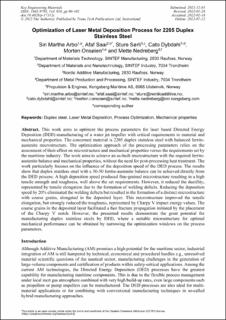| dc.contributor.author | Arbo, Siri Marthe | |
| dc.contributor.author | Saai, Afaf | |
| dc.contributor.author | Sørli, Sture | |
| dc.contributor.author | Dybdahl, Cato | |
| dc.contributor.author | Onsøien, Morten Ingar | |
| dc.contributor.author | Nedreberg, Mette | |
| dc.date.accessioned | 2023-03-03T12:40:26Z | |
| dc.date.available | 2023-03-03T12:40:26Z | |
| dc.date.created | 2022-07-25T16:34:33Z | |
| dc.date.issued | 2022 | |
| dc.identifier.citation | Key Engineering Materials. 2022, 926, 90-102. | en_US |
| dc.identifier.issn | 1013-9826 | |
| dc.identifier.uri | https://hdl.handle.net/11250/3055761 | |
| dc.description.abstract | This work aims to optimize the process parameters for laser based DED manufacturing of a water jet impeller with critical requirements to material and mechanical properties. The concerned material is 2205 duplex stainless steel with balanced ferrite-austenite microstructure. The optimization approach of the processing parameters relies on the assessment of their effect on microstructure and mechanical properties versus the requirements set by the maritime industry. The work aims to achieve an as-built microstructure with the required ferrite-austenite balance and mechanical properties, without the need for post-processing heat treatment. The work particularly focuses on the influence of the deposition speed of the DED process. The results show that duplex stainless steel with a 50-50 ferrite-austenite balance can be achieved directly from the DED process. A high deposition speed produced fine-grained microstructure resulting in a high tensile strength and toughness, well above the set requirements. However, it reduced the ductility, represented by tensile elongation due to the formation of welding defects. Reducing the deposition speed by 20% eliminated the welding defects but resulted in the formation of a distinct microstructure with coarse grains, elongated in the deposited layer. This microstructure improved the tensile elongation, but strongly reduced the toughness, represented by Charpy V impact energy values. The coarse grains in the deposited layer facilitated a fast fracture propagation initiated by the placement of the Charpy V notch. However, the presented results demonstrate the great potential for manufacturing duplex stainless steels by DED, where a suitable microstructure for optimal mechanical performance can be obtained by narrowing the optimization windows on the process parameters. | en_US |
| dc.language.iso | eng | en_US |
| dc.publisher | Trans Tech Publications | en_US |
| dc.rights | Navngivelse 4.0 Internasjonal | * |
| dc.rights.uri | http://creativecommons.org/licenses/by/4.0/deed.no | * |
| dc.subject | Stål | en_US |
| dc.subject | Steel | en_US |
| dc.subject | Additiv tilvirkning | en_US |
| dc.subject | Additive manufacturing | en_US |
| dc.subject | Additive manufacturing | en_US |
| dc.subject | Additive manufacturing | en_US |
| dc.title | Optimization of Laser Metal Deposition Process for 2205 Duplex Stainless Steel | en_US |
| dc.type | Peer reviewed | en_US |
| dc.type | Journal article | en_US |
| dc.description.version | publishedVersion | en_US |
| dc.rights.holder | © 2022 The Author(s). | en_US |
| dc.subject.nsi | VDP::Materialteknologi: 520 | en_US |
| dc.subject.nsi | VDP::Materials science and engineering: 520 | en_US |
| dc.source.pagenumber | 90-102 | en_US |
| dc.source.volume | 926 | en_US |
| dc.source.journal | Key Engineering Materials | en_US |
| dc.identifier.doi | 10.4028/p-17112c | |
| dc.identifier.cristin | 2039463 | |
| dc.relation.project | EC/H2020/728053-MarTERA | en_US |
| dc.relation.project | Norges forskningsråd: 311505 | en_US |
| cristin.ispublished | true | |
| cristin.fulltext | original | |
| cristin.qualitycode | 1 | |

